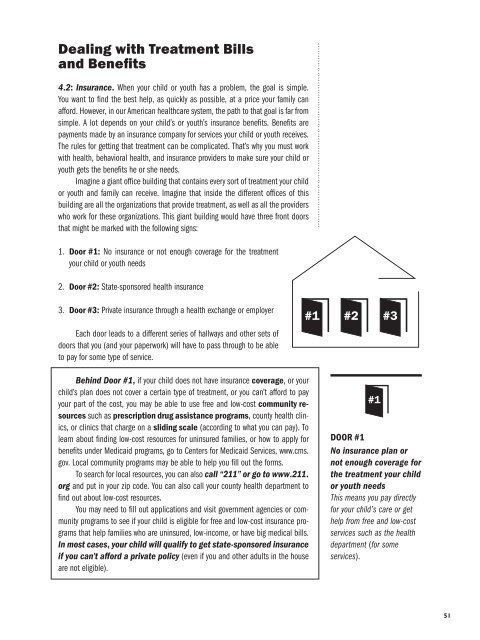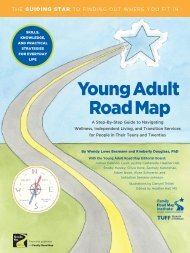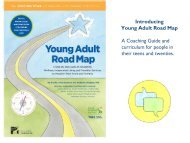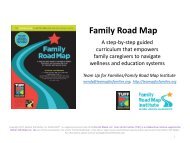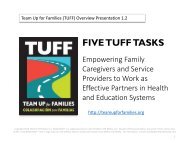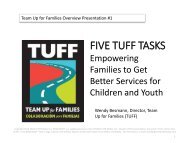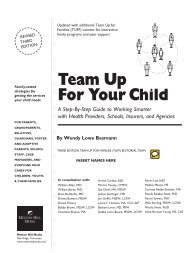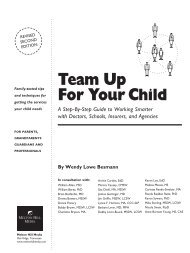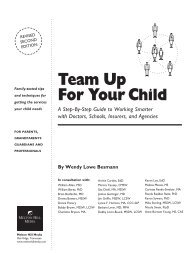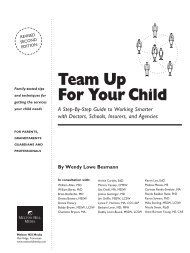Family Road Map Guide
You also want an ePaper? Increase the reach of your titles
YUMPU automatically turns print PDFs into web optimized ePapers that Google loves.
Dealing with Treatment Bills<br />
and Benefits<br />
4.2: Insurance. When your child or youth has a problem, the goal is simple.<br />
You want to find the best help, as quickly as possible, at a price your family can<br />
afford. However, in our American healthcare system, the path to that goal is far from<br />
simple. A lot depends on your child’s or youth’s insurance benefits. Benefits are<br />
payments made by an insurance company for services your child or youth receives.<br />
The rules for getting that treatment can be complicated. That’s why you must work<br />
with health, behavioral health, and insurance providers to make sure your child or<br />
youth gets the benefits he or she needs.<br />
Imagine a giant office building that contains every sort of treatment your child<br />
or youth and family can receive. Imagine that inside the different offices of this<br />
building are all the organizations that provide treatment, as well as all the providers<br />
who work for these organizations. This giant building would have three front doors<br />
that might be marked with the following signs:<br />
1. Door #1: No insurance or not enough coverage for the treatment<br />
your child or youth needs<br />
2. Door #2: State-sponsored health insurance<br />
3. Door #3: Private insurance through a health exchange or employer<br />
Each door leads to a different series of hallways and other sets of<br />
doors that you (and your paperwork) will have to pass through to be able<br />
to pay for some type of service.<br />
#1 #2 #3<br />
Behind Door #1, if your child does not have insurance coverage, or your<br />
child’s plan does not cover a certain type of treatment, or you can’t afford to pay<br />
your part of the cost, you may be able to use free and low-cost community resources<br />
such as prescription drug assistance programs, county health clinics,<br />
or clinics that charge on a sliding scale (according to what you can pay). To<br />
learn about finding low-cost resources for uninsured families, or how to apply for<br />
benefits under Medicaid programs, go to Centers for Medicaid Services, www.cms.<br />
gov. Local community programs may be able to help you fill out the forms.<br />
To search for local resources, you can also call “211” or go to www.211.<br />
org and put in your zip code. You can also call your county health department to<br />
find out about low-cost resources.<br />
You may need to fill out applications and visit government agencies or community<br />
programs to see if your child is eligible for free and low-cost insurance programs<br />
that help families who are uninsured, low-income, or have big medical bills.<br />
In most cases, your child will qualify to get state-sponsored insurance<br />
if you can’t afford a private policy (even if you and other adults in the house<br />
are not eligible).<br />
#1<br />
DOOR #1<br />
No insurance plan or<br />
not enough coverage for<br />
the treatment your child<br />
or youth needs<br />
This means you pay directly<br />
for your child’s care or get<br />
help from free and low-cost<br />
services such as the health<br />
department (for some<br />
services).<br />
51


